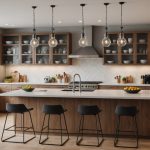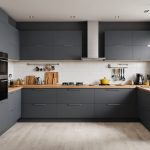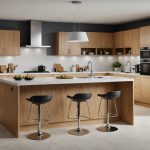Understanding Acoustic Panels
Acoustic panels are essential tools for effective sound management. Made from materials like foam, fabric, or wood, they help absorb and dampen noise. This is crucial in kitchen design, where hard surfaces can exacerbate sound levels. By controlling these acoustics, the overall kitchen design can be transformed into a more pleasant environment both visually and acoustically.
In kitchens, noise management is pivotal. Excessive sound can lead to stressful experiences during cooking or social gatherings. The noise of clattering dishes or humming appliances can be intrusive. Acoustic panels mitigate this by reducing echo, creating an environment where conversations and meal preparations occur simultaneously without disturbance.
This might interest you : Transform your diet: discover how a programmable coffee maker with calorie tracking can enhance your wellness journey
Acoustic design isn’t just about functionality; it also enhances aesthetics. Panels come in various styles and colors, contributing to the visual appeal of a kitchen. When integrated thoughtfully, they can complement existing decor, highlighting the kitchen’s design without overwhelming it. Therefore, combining acoustic panels effectively balances sound management with a harmonious kitchen appearance, making the space more enjoyable to inhabit and use.
Benefits of Acoustic Panels in Reducing Stress
In the kitchen, the constant buzz of appliances or the clatter of dishes can elevate stress levels. This is where the role of acoustic panels becomes pivotal. By offering acoustic comfort, these panels help to construct a serene setting, reducing the impact of disruptive sounds. A quieter environment not only minimizes stress but can also promote a more relaxed and enjoyable cooking experience.
In the same genre : Transform your kitchen with a yogurt maker: enjoy guilt-free indulgence and health benefits!
Case studies reveal the psychological impact of sound control on mental well-being. Kitchens integrated with proper acoustic solutions exhibit lower levels of stress in daily activities. Participants in these studies reported feeling more at ease in acoustically optimized spaces, supporting the idea that thoughtful sound management has tangible mental health benefits.
Experts suggest that beyond visually enhancing your kitchen, these panels allow for the creation of a calming environment. By installing acoustic materials, you contribute to a more peaceful atmosphere, benefiting both the mind and body. Leveraging the acoustic panels empowers homeowners to transform a bustling kitchen into a tranquil area, which in turn, helps to significantly reduce stress.
Influence of Kitchen Acoustics on Eating Habits
The role of kitchen acoustics in shaping eating behaviors is increasingly recognized, with research suggesting a strong link between sound environments and food intake. A well-balanced acoustic environment can encourage mindful eating, while noisy settings might lead to what some researchers identify as “distracted eating,” which often contributes to overeating.
In various studies, participants exposed to loud or disruptive noise during meals tended to eat more quickly, consuming larger quantities without realising it. Conversely, a calm and serene soundscape allowed diners to focus on their meals, enhancing the overall food experience by promoting slower, more deliberate eating.
To create an acoustically conducive environment for healthy eating, consider the strategic installation of acoustic panels to reduce excess noise. By selecting panels that complement existing kitchen decor while optimizing sound quality, you can transform your kitchen into a space that facilitates healthy eating habits. Thoughtful placement around dining areas or kitchens can help buffer unwanted sounds, fostering an atmosphere where individuals feel encouraged to savour each bite. The result is a more pleasurable and health-conscious dining experience.
Selecting the Right Acoustic Panels for Your Kitchen
Choosing the right acoustic panels for your kitchen involves several crucial considerations. Firstly, understanding the kitchen acoustics is essential to maximise sound management. Consider the size and shape of your kitchen, as well as the primary sources of noise, such as appliances and high-traffic areas. With this information, you’ll be better prepared to select panels that cater to your specific needs in sound absorption and diffusion.
When it comes to materials, options like foam, fabric, or wood are popular due to their sound-absorbing properties. Foam panels are excellent for reducing echo, while fabric-covered ones offer additional aesthetic flexibility. Wooden panels, meanwhile, can blend well with various design choices, giving a warm, natural feel to your kitchen.
Panel placement is another vital factor. Aim to install panels in areas where sound reflects most, such as on ceilings and walls opposite noise sources. This strategic placement enhances their effectiveness in sound management, creating a more acoustically pleasant environment. Investing time in the right acoustic panel selection will ultimately improve the auditory and visual appeal of your kitchen, ensuring a harmonious space.
Installation Tips for Acoustic Panels
Installing acoustic panels in your kitchen can significantly enhance sound management and aesthetics. Begin by assessing the kitchen layout to identify areas prone to noise reflection, such as hard countertops or walls near appliances. Precise placement of panels in these areas can effectively dampen echoes and improve acoustic quality.
For a DIY installation, essential tools include a level, measuring tape, adhesive or mounting clips, and a saw for size adjustments. Start by marking the desired panel positions using a pencil or chalk. Ensure the alignment is even before using adhesive or clips to secure the panels to the walls or ceiling. Common errors include uneven placement, overusing adhesives, or cutting panels inaccurately, which can affect their effectiveness.
While DIY projects can be gratifying, sometimes professional help is warranted, especially in large kitchens or if you desire intricate panel arrangements. Experts can offer tailored advice, ensuring the panels are both functional and seamlessly integrated into your kitchen’s design. Their expertise often results in a more polished look, maximizing the panels’ ability to enhance your kitchen acoustically and visually.
Expert Recommendations and Case Studies
Engaging with expert advice reveals valuable insights on acoustic panel integration in kitchens. Renowned interior designers suggest prioritising functional and aesthetic balance, ensuring the panels cater to the specific sound management needs while complementing the overall kitchen design.
Consulting case studies highlights kitchens that successfully utilised acoustic solutions, demonstrating substantial improvements in sound quality and aesthetic appeal. For instance, one study compared several kitchens before and after panel installation. Kitchens lacked acoustic optimisation before, leading to elevated noise levels and diminished acoustic comfort. Post-installation, users reported reduced stress, enhanced social interactions, and atmosphere improvements.
Designers recommend using material combinations like fabric and wood for a harmonious look and feel. This integration not only dampens sound but enhances visual continuity. Notably, in one example, fabric panels were chosen to match soft furnishings, while wood complemented existing cabinetry.
The effectiveness of acoustic panels in kitchen environments is apparent in these trials. Moreover, precise placement is crucial to achieve optimal sound absorption and diffusion, with success stories affirming the relevance of expert recommendations and detailed planning.
Visual Inspiration for Acoustic Panel Placement
For those seeking design inspiration in incorporating acoustic panels, exploring varied kitchen visuals can be enlightening. Examining how different acoustic panel placements enhance both aesthetics and functionality is invaluable. From modern minimalist kitchens to classic, rustic designs, acoustic solutions can seamlessly blend into any style.
In contemporary kitchens, panels are often strategically camouflaged within sleek cabinetry or expansive open shelves, fostering a harmonious appearance. In contrast, rustic designs may utilise wooden panels that accentuate natural textures, adding warmth and character. Ensuring that panel colours and materials align with existing elements is key to maintaining visual continuity.
Colour coordination plays a pivotal role. For instance, neutral-toned panels can complement a minimalist’s clean palette, while bold, vibrant panels can serve as a focal point in more eclectic settings. Attention to layout is crucial, allowing the panels to merge with structural features like pillars or recessed ceilings, enhancing the kitchen’s architectural rhythm.
Tips for successful integration include:
- Consultation with interior designers for bespoke advice.
- Testing material samples against your current decor.
- Balancing acoustic efficiency with stylistic preferences, creating a visually appealing and acoustically balanced environment.










